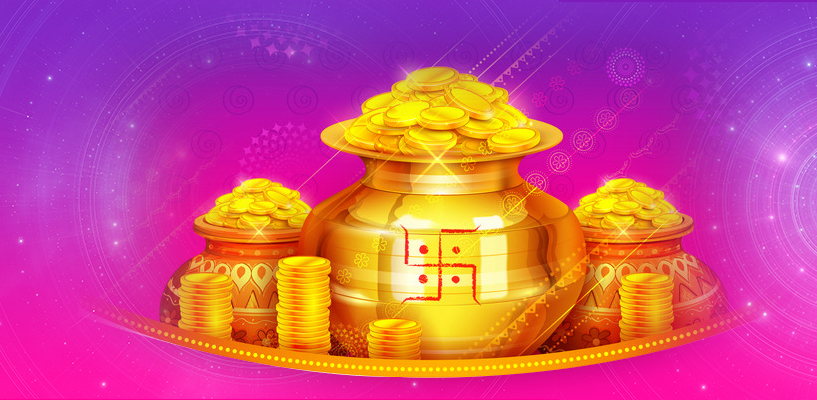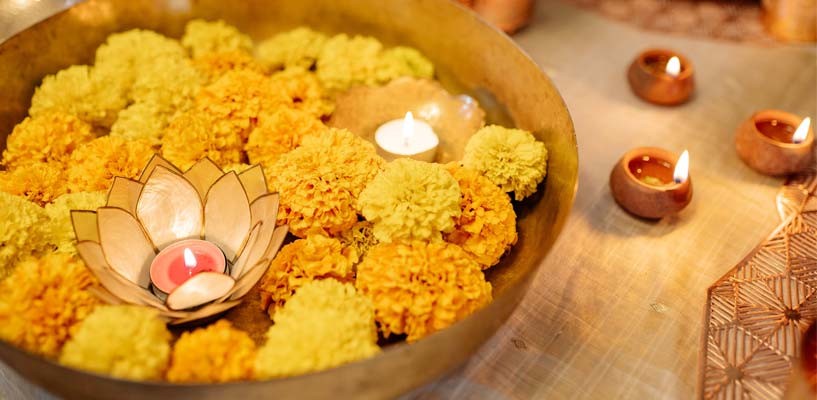Durga Puja, 2-13 Oct 2024: Significance & Auspicious Time
Durga Puja, an important Hindu festival, celebrates the power of Goddess Durga, the divine feminine (Shakti) and the victory over evil forces. Read this article to learn about the significance of Tithis & dates during this festival, rituals performed, the spirit of Goddess Durga’s idol and that of collective worship.
Durga Puja is one of the major festivals of Hinduism, traditionally celebrated for 10 days in the month of Ashvin (September – October) and particularly celebrated in Bengal, Assam and other eastern states of India. It symbolizes the victory of Goddess Durga over the invincible Mahishasura and celebrates the divine feminine (Shakti).
Claim your 30 page FREE horoscope reading based on Vedic Astrology principles, which consider Moon Sign for more accuracy.
The environment begins to vibrate with Durga Puja fervour from Mahalaya, which is the last day of Pitru Paksha (a 16-lunar day period when Hindus pay homage to their ancestors), and officially starts from form the Sashti Tithi (the 6th day) when Goddess Durga is celebrated in various forms as Durga, Lakshmi and Saraswati. It ends with Vijayadashami with loud chants and drumbeats.
How is Durga Puja celebrated?
In northern India, people fast and light a lamp for nine days, a practice known as ‘Akhand Jyot’. They end this period of fast with Kanjak, where they invite nine girls below the age of 10 to their house and distribute gifts and offerings. It is believed that these ‘kanyas’ or girls are the forms of Goddess Durga. In Gujarat, the festival is also celebrated with the ‘Garba’ dance.
In southern India, people decorate the altar by organising steps in odd numbers and place toys and effigies of all deities. They invite everyone for a feast and exchange gifts. Each night is dedicated to the different forms of Goddess Durga.
Durga Puja Dates
- Starts on 2nd October 2024 and ends on 13th Oct 2024
What is the significance of the Tithi and Dates during this period?
Mahalaya (2nd October 2024)
It is on this day that Goddess Durga arrives on earth. On Mahalaya, Hindus pay homage to their ancestors.
Sashti (8th October 2024)
On Shashti, which is the sixth day of the Durga Puja festival, Goddess Durga’s idol is revealed to the public.
Auspicious time: 11:20:07 on 8 October till 12:16:29 on 9 October 2024
Saptami (9th October 2024)
Goddess Durga’s idol is invoked with life by the ritual of Pran Pratishtha. A banana tree is dressed in a sari and bathed in a river like a newly wedded bride and the process is called ‘Kola Bou’.
Auspicious time: 12:16:29 on 9 October till 12:33:48 on 10 October.
Ashtami (10th October 2024)
Goddess Durga is worshipped as a young, virgin girl in a ritual called ‘Kumari Puja’. Sandhi Puja is performed to worship Chamunda Devi’s form of Goddess Durga.
Auspicious time: 12:33:48 on 10 October till 12:08:52 on 11 October.
Navami (11th October 2024)
This is the last day of the festival when a Maha Arti (symbolic of removing darkness) is organized to mark the conclusion of the festival.
Auspicious time: 12:08:52 on 11 October till 11:00:45 on 12 October.
For details on how to conduct the Navami Puja, CLICK HERE
Vijaya Dashami (12th October 2024)
On the 10th day, the idol of Goddess Durga is taken for immersion to the river.
Auspicious time for Puja: 14:02:54 till 14:49:09 on 12 October.
Aparahan Muhurat: 13:16:39 to 15:35:25 on 12 October.
Durga Visharjan Muhurat: 13th October 2024, 6:20:57 till 8:39:23.
Significance of Goddess Durga’s idol
Though the festival starts in September or October, the artisans start making the idols months before, during summer. The process begins with prayers to Lord Ganesha and to the perceived divinity in materials such as bamboo frames in which the idols are cast.
The process of sculpture making starts with the clay, or alluvial soil, collected from different regions to form the base. It is believed that Goddess Durga is Prakriti (Mother Nature), present everywhere in the universe. The custom is to include soil samples in the clay mixture of Goddess Durga from areas believed to be ‘nishiddho pallis’ (forbidden territories such as brothels).
The clay is combined with straw, kneaded and molded into cast made from hay and bamboo. Then it is given shape, painted, polished, decorated, and displayed in the pandal for Durga Puja.
Collective Worship
This festival is a social and public event in the eastern and northeastern states of India, where it dominates religious and socio-cultural life. Temporary pandals are built at community squares, roadside shrines and temples. The festival starts at twilight with prayers to Goddess Saraswati, a manifestation of Goddess Durga who resides in all creations, in everything and everywhere.
On this day, the eyes of Goddess Durga are made. Ganesha Puja is also performed and devotees visit the pandal temples. Day Two represents the remembrance of the Goddess and her manifestations, such as Kumari (goddess of fertility), Mai (mother), Ajima (grandmother), Lakshmi (goddess of wealth) and, in some regions, as the Saptamatrikas (seven mothers) or Navadurga (nine manifestations of Durga). From Sashti Tithi, major festivities and social celebrations start.
Puja Ritual
- Paata Puja: The process of making an idol begins from Paata Puja on the day of Rath Yatra around July. Paata is the wooden frame that forms the idols.
- Bodhana: Involves rites to awaken and welcome the Goddess to be a guest, typically done on the sixth day of the festival.
- Adhivasa: Anointing rituals with symbolic offerings made to Goddess Durga; it is believed that each offering represents subtle forms of the Goddess. It is completed on the 6th day.
- Navapatrika Snan: Bathing of the navapatrika (nine planets) with holy water; done on the 7th day of the festival.
- Sandhi Puja and Ashtami Pushpanjali: They are performed on the 8th day which is at the cusp of the ending of the 8th day and beginning of the 9th day as it is considered to be the moment when Goddess Durga was in a battle with Mahishasura and attacked by the demons Chanda and Munda.
Goddess Chamunda emerged from the third eye of Goddess Durga; killed Chanda and Munda at the cusp of Ashtami and Navami (8th and 9th day respectively). This moment is celebrated as Sandhi Puja by offering 108 lotuses and the lighting of 108 lamps.
This ritual is performed in the last Ashtami Tithi of 24 minutes and first 24 minutes of Navami Tithi. The surrogate effigy is smeared with red vermillion to symbolize spilled blood. The Goddess is then offered food (‘bhog’). - Dhunuchi Naach and Dhuno Pora: Dhunuchi Naach is a dance ritual performed with ‘dhunuchi’ (incense burner). Drummers called Dhakis, carrying large leather–strung ‘dhaks’ create music and do Puja and Arti.
- Yagna and Bhog: The 9th day of the festival is marked with a yagna (fire oblation) and bhog (feast). Some also perform Kanya Puja or Kanjak.
- Sindoor Khela and Immersion: The 10th and last day, called Vijayadashami, is marked by Sindoor Khela, where women smear sindoor or vermillion on the idols and also smear each other with it. Following the immersion, Durga is believed to return to her mythological marital home of Kailasha to Shiva and the cosmos in general. Distribution of sweets, gifts and family visits mark this day.
Visarjan – The farewell to Goddess Durga
On Vijayadashami, the idol of Durga and other effigies are carried through a huge procession to the local river, where they are immersed and this custom is followed as symbolic of the departure of the deity to her home and to her husband, Shiva, in the Himalayas. The idols are biodegradable made of clay soil, straw, and wood.
The environmental activists have raised the concern and banned the use of hazardous paints, and various state governments have started distributing lead free paints to artisans at no cost to prevent pollution. Images of the Goddess along with the huge lion, the demon Mahishasura, the different pandals decorated with bamboo structures, and temples are then removed.

Vimsottari Dasa Reading
Get a Vimsottari Dasa Reading by our Vedic astrologer to time events in your life most accurately. Learn about your best period for career, love, finances, public recognition, etc. Identify sudden unexpected changes for the good or worse. more

 What Should You Do to Attract Prosperity on Dhanteras?
What Should You Do to Attract Prosperity on Dhanteras?

 Akshaya Tritiya: The Spring Festival of Prosperity
Akshaya Tritiya: The Spring Festival of Prosperity
 Astrological Significance of Decorating your House on Diwali
Astrological Significance of Decorating your House on Diwali
 Significance of Ganapati Yagna
Significance of Ganapati Yagna
